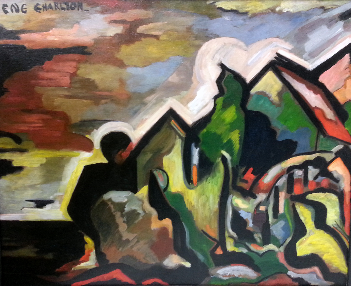| CASETA has been working with the TACO (Texas Art Collectors Organization) group in Dallas who have agreed to allow us to record their upcoming program with Randy Tibbits this Sunday and make it available on our website. We are very pleased to report that the board of TACO has also agreed to allow CASETA members live access to the upcoming Zoom meeting on Sunday featuring Randy Tibbits. If you are not able to watch the presentation live on Sunday we will still be recording the session and with the permission of TACO making it available on our website afterwards. This kind of sharing of programs is beneficial to all of you who are passionate about the visual arts heritage of Texas and we are deeply grateful to TACO for allowing us to have direct access to this wonderful program. |

| TACO: Texas Art Collectors Organization virtual ZOOM meeting “Houston/Dallas Modernism(s) in the 1930s: So Close, and Yet so Different” presented by Randy Tibbits Sunday, May 23, 2021 3-4 pm ”Exterior No.1, Arrangement Around Two Houses”, Gene Charlton, ca. 1936, private collection To Join This Presentation: Simply click on this link on Sunday, May 23 at 3 pm to join and enter the Meeting ID: https://smu.zoom.us/j/94743919831 Meeting ID: 947 439 9831 One tap mobile: +13462487799,,9474399831# US (Houston) As a reminder, please set Zoom to Active Speaker View. |
 |
| “West Texas Town, Adrian” Jerry Bywaters, 1938, Dallas Museum of Art. |  |
| Houston and Dallas Modernism(s) in the 1930s: So Close and Yet So Different |
 |
| In both Houston and Dallas during the 1930s, Modernism became the central focus for two small groups of local artists, made up mostly of youngsters, along with their forward-looking mentors: in Houston, the Cherry-McNeill Group; and the Dallas Nine (plus) up north. Though not even 250 miles apart, the approaches to Modernism of the two groups in the two cities were markedly different, and were in some respects a microcosm of the different paths to Modernism on the national level. The Cherry-McNeill Group brought a “scientific” approach to art (as Emma Richardson Cherry described it in 1920), concerned as much, or maybe more, with the way art is made than with the subjects depicted. Cherry drew her inspiration from extensive study in Paris and New York, and contact with such artists as Marsden Hartley, Marcel Duchamp and Andre Lhote. She enthusiastically embraced the Modernism current in Europe and New York, and her group eagerly absorbed the lessons in modern art she shared with them. |
 |
| The Dallas Nine, on the other hand, founded their art-making on the conviction, as Jerry Bywaters put it in 1928, that “art, to be significant, must be a reflection of life; that it must be a part of a people’s thought.” Technique in art-making was not immaterial to them, and indeed they looked for guidance to Italian primitives, landscape artists and even Surrealists, but the subject was all important, and the subject had to be the land and people of their own region. They actively rebelled against the “European domination of American art,” as Bywaters said, and found their chief inspiration in the work of Mexican muralists, and American regionalists such as Thomas Hart Benton. Considering these two groups of artists together, both working in parallel to develop modern ways of art-making, demonstrates that Modernism, when it came to America, was not limited exclusively to the art centers of the East and that it was not a single thing, even in a relatively contained region such as Texas. It was, rather, a liberating force that could take its disciples along markedly different routes toward the shared ideal of creating a modern art for America. |
 |
| | CASETA | 325.212.4872 | [email protected] | www.caseta.org |



